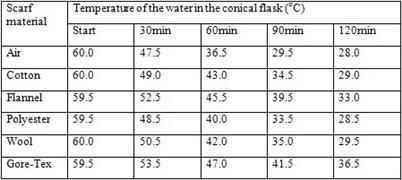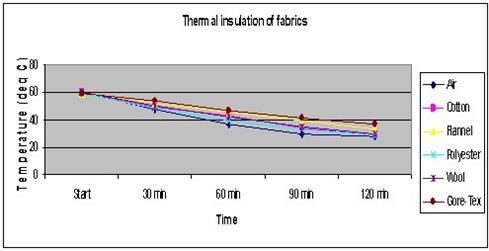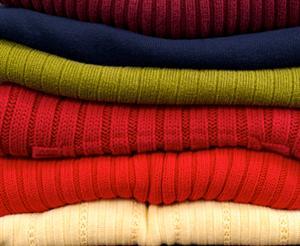| Complexity level: | 4 |
| Project cost ($): | 30 |
| Time required: | It will take an hour to set up the experiment, and 2 hours to conduct it |
| Material availability: | The clothes can be purchased from a departmental store |
| Safety concerns: | Be careful when handling hot water. An adult is required for the operation of the drill. |
Hypothesis
Of the five types of fabric, wool has the greatest heat-retention properties.
Overview
The thermal insulation property of clothes
We wear clothes in order to keep ourselves warm when the weather is cold. When the weather is hot, clothes protect us from the harmful ultraviolet rays which cause sun-burn and in cases of severe exposure, increase the risk of contracting skin cancer Clothes act as a protective outer layer for our skin: it protects us from insect bites, and lowers our chances of being injured. They also protect us from extreme weather conditions – snow, rain and strong winds.
Culture, nationality and the environment influence how individuals dress. Individuals’ status and personal preferences play a role too. Mankind has People have learned to dress in ways that suit environmental conditions. For example, tribes that live in hot African outbacks dress sparsely while individuals who live in cold climates (eg. eskimos) wear thick clothes that keep them warm.
Some countries experience the 4 seasons. It is important for individuals who reside in such countries to choose their clothes according to prevailing environmental conditions. During winter, they should wear cotton or woolen clothes because cotton and wool are poor heat conductors. Winter clothes keep us warm because the gaps in their fibers trap air, which acts as a thermal insulator. In general, clothes are made from both natural and synthetic fibers.
Scientific Terms
Materials
The materials required for this science fair project are as follows:
- 6 conical flasks
- 6 corks, each large enough to close off the openings of the flasks
- an electric drill
- 6 thermometers
- a cotton scarf
- a flannel scarf
- a polyester scarf
- a woolen scarf
- a Gore-Tex jacket
- a hot plate
- tap water
- a measuring cylinder
- a clock
Procedure
1. For this experiment, the independent variable is the type of fabric used to insulate the flasks (air, cotton, flannel, polyester, wool or Gore-Tex). The dependent variable is the temperature of the water in the flasks. Measure this using a thermometer. The constants (control variables) are the size of the flasks, the amount of water in the flasks, and the temperature of the water in the flasks as well as the temperature of the air in the room.
2. Use an electric drill to make holes in the center of 6 corks. These holes should be able to fit a thermometer. Insert 6 thermometers through the holes.
3. Fill each of the 6 conical flasks with the same amount of tap water. Cover the opening of each flask using a cork that has a thermometer attached. Ensure that the thermometers are in the flasks. Adjust the thermometers so that their tips touch the water in the flasks.
4. Place the 6 conical flasks on a hot plate and heat them until the water reaches 60°C.
5. The first conical flask is to be the control. Do not cover it with fabric. Wrap the other 5 conical flasks with a cotton scarf, a flannel scarf, a polyester scarf, a woolen scarf and a Gore-Tex jacket.
6. Start the clock. The first temperature measurement should be taken from the 6 thermometers and recorded in the table below. Check the temperature of the water in the flasks every 30 minutes for the next 2 hours and recorded this in the table below.


Results
The following results were observed for this science fair project:

Among the fabrics, Gore-Tex kept the water in the flask warm for the longest period of time. The water in the flask wrapped with polyester was the first to turn cold.

Conclusion
The hypothesis does not hold true: among the fabrics, wool did not keep the water in the flask warm for the longest period of time.
Ideally, clothes should be comfortable. They must be thermal-resistant in order to protect their wearers from cold weather. In hot climates, people should wear clothes that allow water vapor to pass through. Today, there are many kinds of commercially available, patented fabrics which are light, yet they provide good thermal insulation.
Also consider
Use other materials such as fur, silk and leather.
Use thicker clothes. How do the results compare?
References
Clothing - http://en.wikipedia.org/wiki/Clothing
12 tips to help you choose warm clothes - http://www.websiterepairguy.com/articles/household_tips/stay_warm.html

